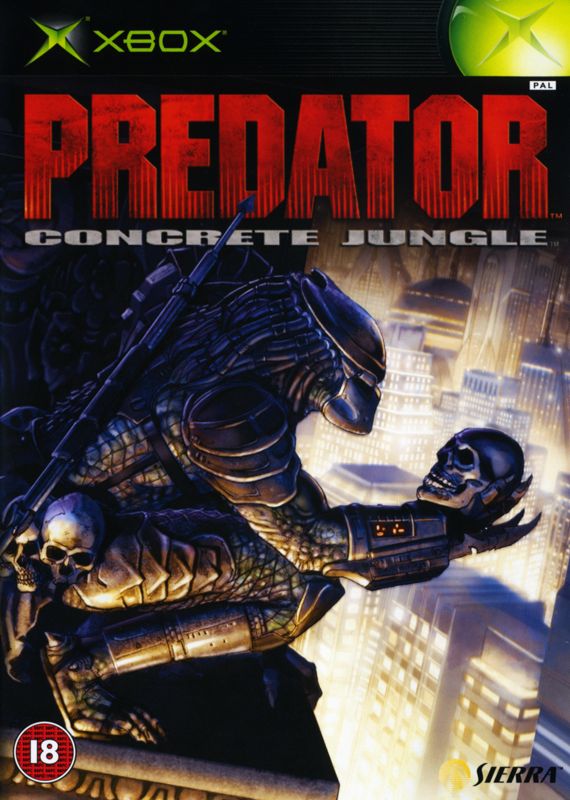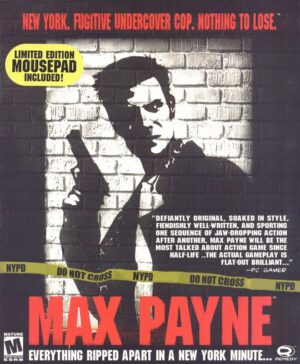Retro Replay Review
Gameplay
Predator: Concrete Jungle places you directly in the armored feet of Scarface, a dishonored Yautja hunter on a relentless quest to reclaim his lost arsenal. The third-person perspective offers a satisfying blend of stealth and brutal melee, allowing players to stalk human and mechanical prey alike. Whether you’re sneaking through dark alleyways with your cloaking device or charging headlong into combat with the wrist blades bared, the flow between player-driven choice and cinematic spectacle remains strong throughout.
Combat revolves around a mix of upgradeable melee weapons—such as the glaive, combistick, maul, and iconic wrist blades—and ranged tools like the spear gun and shoulder-mounted plasma caster. Each weapon has distinct strengths: glaives can be hurled in sweeping arcs, mauls deliver bone-crushing stun blows, and the plasma caster provides pinpoint energy bursts. Progression feels meaningful, as collecting human trophies and completing side objectives grants experience that unlocks weapon upgrades and new Predator masks, each offering unique stat boosts.
Objectives in Concrete Jungle are spread across distinct “levels” within Neonopolis, from abandoned subway tunnels to neon-lit rooftops. While the structure can feel linear—clear out a gang, retrieve a trophy, move to the next zone—the varied enemy designs (mobsters, cyborgs, heavily armed soldiers, even rival Predators) and environmental hazards keep encounters engaging. Occasional puzzles require you to manipulate machinery or stealth past high-security zones, breaking up the relentless action with tactical considerations.
Graphics
Despite its mid-2000s origins, Predator: Concrete Jungle still impresses with its atmospheric cityscapes. Neonopolis glows under rain-slick streets and flickering signs, creating a juxtaposition of Art Deco-inspired architecture and futuristic cyberpunk elements. Dynamic lighting highlights the Predator’s cloak shimmer and adds tension to shadowy corridors, invoking the franchise’s classic suspenseful feel.
Character and creature models showcase a level of detail that holds up reasonably well: Scarface’s armored plating, guttural growls, and blood-splattered trophy display all capture the brutal essence of the hunt. Enemies display visible wear on weapons and clothing, and mechanical foes sport a convincing industrial design. On modern hardware, some textures appear a bit soft, and distant environmental geometry can look blocky, but these minor flaws rarely detract from the overall mood.
Special effects—thermal vision, energy plasma bursts, explosive self-destruct sequences—are a visual treat that inject variety into each play session. Rippling heat distortions during cloak sequences and the visceral spray of blood during melee executions remind players why Predator remains an iconic sci-fi antagonist. Occasional framerate dips can occur in large-scale firefights, but they seldom undermine the immersive presentation.
Story
The narrative thrust of Concrete Jungle takes the one-eyed Predator—Scarface—through a century-spanning exile and back into the heart of the city responsible for his downfall. The opening flashback to 1930’s New Way City establishes the stakes clearly: a wounded hunter stripped of his honor by bungled hubris, forced to self-destruct his ship and face clan exile. This rich backstory adds weight to Scarface’s return to the rebranded Neonopolis and his relentless pursuit of redemption.
Fast-forward a hundred years, and both the city and its underworld alliances have evolved, producing new rival gangs, corrupt officials, and military operations all vying for control. The plot weaves in classic Predator tropes—trophies, honor codes, and clan politics—while introducing fresh adversaries like augmented cyborgs and advanced robotic sentries. Cutscenes balance quiet, tension-building moments with bursts of action, effectively conveying the Predator’s alien perspective without a single spoken word.
While the overarching revenge storyline drives Scarface forward, side missions and collectible intel flesh out the world’s lore. Discovering hidden data logs reveals corporate conspiracies and gang hierarchies, motivating you to hunt specific targets before heading deeper into Neonopolis’s neon-soaked ruins. Occasional pacing hiccups arise when objectives feel repetitive, but overall the narrative remains tightly intertwined with gameplay, giving each level a clear purpose and emotional resonance.
Overall Experience
Predator: Concrete Jungle delivers a distinctive hunting experience that successfully merges stealth, melee combat, and sci-fi spectacle. The game’s pacing—alternating between stalking unsuspecting foes and engaging in all-out battles—keeps gameplay fresh. Unlockable Predator masks and costumes add replay value, inviting completionists to revisit earlier levels with new power-ups and visual flair.
Sound design further elevates the immersion: the low-frequency rumble of the plasma caster, the sickening crack of a spinal cord extraction, and the haunting distant growls of rival Predators all underscore the game’s brutal tone. The original soundtrack blends tribal percussion riffs and industrial synths, reinforcing the sense of alien menace amid urban decay.
Though some elements show their age—linear level design, occasional texture pop-in, and mild repetition—the core experience remains thrilling. Predator: Concrete Jungle stands out not only as a faithful adaptation of the franchise’s themes but also as a compelling action title in its own right. For fans of visceral third-person combat and atmospheric sci-fi worlds, this game continues to be a worthy hunt decades after its initial release.
 Retro Replay Retro Replay gaming reviews, news, emulation, geek stuff and more!
Retro Replay Retro Replay gaming reviews, news, emulation, geek stuff and more!




Reviews
There are no reviews yet.